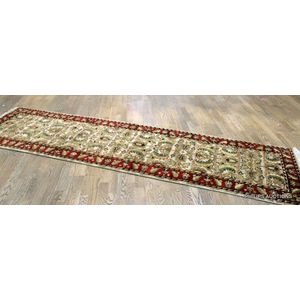Indian Wool Runner with William Morris Inspired Design
An Indian wool runner, featuring a formal William Morris inspired floral and oak leaf design in olive, gold, red and black colours upon a wheaten field enclosed by a main russet border with similar leaf and floral motifs and narrow bands, length 305 cm, width 78 cm
You must be a subscriber, and be logged in to view price and dealer details.
Subscribe Now to view actual auction price for this item
When you subscribe, you have the option of setting the currency in which to display prices to $Au, $US, $NZ or Stg.
This item has been sold, and the description, image and price are for reference purposes only.
- Morris, William - William Morris (1834 - 1896) an architect designer, artist, writer, poet and social activist is regarded as a leader of the Arts & Crafts movement in England.
After studying theology, ecclesiastical history, medieval poetry and art at Oxford University, Morris began work with a firm of architects for a short period.
In 1861 he formed a company Morris Marshall, Faulkner & Co. was formed to design and produce wallpaper, carpets, tapestries and stained glass, and they initially secured ecclesiastical works, later extending to domestic assignments.
In 1874 he took sole control of the company, buying out the other partners, and renaming it Morris & Co.
The origins of his designs can be traced to medieval Gothic styles but his organic flower and bird motifs encouraged later artists to seek inspiration for their designs in nature. - Oak - Native to Europe and England, oak has been used for joinery, furniture and building since the beginning of the medieval civilisation. It is a pale yellow in colour when freshly cut and darkens with age to a mid brown colour.
Oak as a furniture timber was superceded by walnut in the 17th century, and in the 18th century by mahogany,
Semi-fossilised bog oak is black in colour, and is found in peat bogs where the trees have fallen and been preserved from decay by the bog. It is used for jewellery and small carved trinkets.
Pollard oak is taken from an oak that has been regularly pollarded, that is the upper branches have been removed at the top of the trunk, result that new branches would appear, and over time the top would become ball-like. . When harvested and sawn, the timber displays a continuous surface of knotty circles. The timber was scarce and expensive and was used in more expensive pieces of furniture in the Regency and Victorian periods.
This item has been included into following indexes:
